Girdling Roots:
Many tree species can develop potentially life-threatening girdling roots, but maple species are notorious for developing them in the landscape. As offending girdling roots expand in diameter and press against the also expanding central stem, an inevitable slow decline of the tree begins. When two roots grow together or when two branches grow together, then they can graft and share conducting tissues. However, root and stem tissues cannot graft together, and detrimental effects occur when they expand into one another.
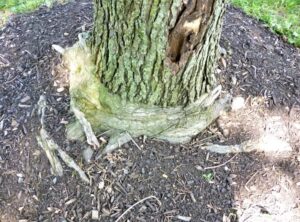
Girdling roots are rare in natural areas, but are relatively common in the urban landscape. (Photo Credit: Steven K. Rettke, Rutgers Coop. Ext.)
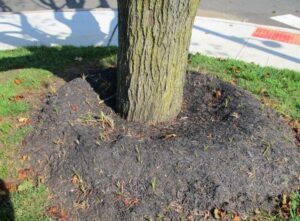
Girdling roots often result when trees are planted too deep. (Photo Credit: Steven K. Rettke, Rutgers Coop. Ext.)
Typically, the growth of the crown declines, leaves display early fall colors, and twig/branch dieback becomes progressively pronounced. A common symptom that can be observed easily from a distance is when the tree trunk goes straight into the ground with no visible flare. With valuable trees, the excavation and removal of offending roots may be considered. This management strategy is only suggested if the tree decline is not too advanced and no more than a couple major girdling roots are involved. One of the primary causes of girdling is when new transplants are initially planted too deep. The causal observation in natural wooded and forested areas indicates that girdling roots are rare at these sites.

Grind-up tree stumps before new trees are placed near it. (Photo Credit: Steven K. Rettke, Rutgers Coop. Ext.)
Grinding Stumps:
Typically, when a tree is removed from a property, the owner requests for tree replacement recommendations. However, it is important to remember to grind-up the old tree stump before any new trees are placed near it. There are several root rotting fungi that can become pathogens to living trees that are nearby. Some of the potential pathogens include Xylaria root rot (Dead Man’s Fingers), Ganoderma lucidum (Ganoderma root & butt rot) and Armillaria mellea (Armillaria root rot). With a sizable food source such as a dead stump, these dead wood decay fungi can eventually become primary pathogens and infect live plants. By grinding the stumps, the food source is mostly removed, and these fungi become less of a threat.
Burl/Knot Growths on Trees:
Some of your clients may be curious about the abnormal growth of knots or burls that occasionally are found on some trees. These mysterious aberrant growths often produce an ugly, distorted appearance and are usually found on certain deciduous trees. The actual cause of these burls is not fully understood, but they seem to be a genetic wound response.
The tree may receive only a relatively mild injury that initiates compartmentalization and callus tissues to form. However, this defensive mechanism within the tree does not seem to be able to shut itself off, resulting in a massive overgrowth of cells on stems or branches. Apparently, there are no pathogens or toxins involved, as is the case with the formation of witches’ brooms. Often the affected trees do not experience any decline and continue to grow.
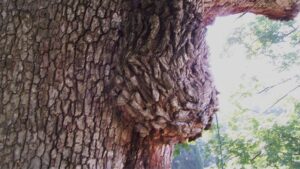
Burls are created from an excessive growth of callus wound tissues. (Photo Credit: Steven K. Rettke, Rutgers Coop. Ext.)
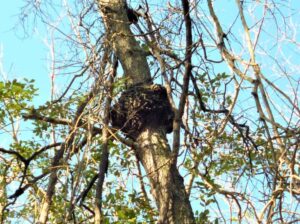
Aberrant burl growths often produce an ugly, distorted appearance. (Phot Credit: Steven K. Rettke, Rutgers Coop. Ext.)
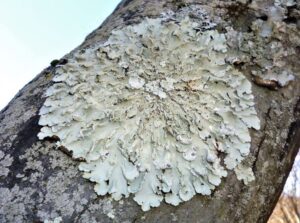
Lichen growth on bark is not considered to be damaging to trees. )Photo Credit: Steven K. Rettke, Rutgers Coop. Ext.)
Lichens Harmful to Trees/Shrubs?:
The blue-green colored lichens growing on the bark of trunks and stems are the well-known mutualistic association between fungi and algae. Lichens have prolific growth when exposed to full sunlight. Sometimes clients may become concerned with lichen growth on their trees or shrubs, especially after crown thinning has opened the canopy and the increased sunlight promotes further growth. Nearly all the literature states that lichens are purely superficial and cause no harm to the health of trees/shrubs. Interestingly, a few non-scientific studies have indicated that lichens may possibly have some detrimental health effects. For example, it has been postulated that lichens may disrupt gas exchange. Furthermore, these organisms can break down rocks and hence, it is suggested some damage to plants do occur. However, until replicated and controlled scientific studies prove otherwise, we should continue to reassure our clients that these curious growths on their trees/shrubs are of no concern. To make them feel even better, tell your skeptical clients that lichens are truly an indicator of clean air.
Drought vs. Frost Cracks:
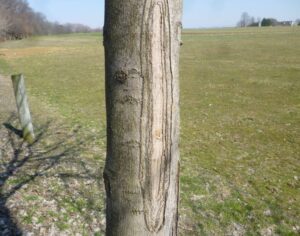
Drought cracks can occur in trunks when tree transplants are allowed to become too dry. (Photo Credit: Steven K. Rettke, Rutgers Coop. Ext.)
Many arborists and landscapers often suggest to their inquiring clients that frost-cracks are the reason for the bark separation within the trunks of trees. Often, however, the actual cause may be from drought stress. Drought-cracks occur most commonly when trees are first planted and a year or so after transplant. The trunks will crack if trees become too dry. Some common trees more susceptible to this condition include maple, honeylocust, crabapple, mountain ash, and London-plane.
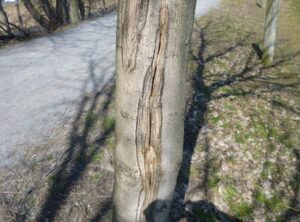
Frost cracks in tree trunks are likely to open & close many times over the years, (Photo Credit: Steven K. Rettke, Rutgers Coop. Ext.)
One of the easiest ways to distinguish between a drought or frost crack is by the way a wound closes. Drought cracks typically represent a one-time event and will generally close or seal almost completely and never re-open again. On the other hand, frost cracks are more likely to continue to open and close over subsequent years. Usually less freezing and thawing stress is required to re-open the crack in the future and the development of a conspicuous callus ridge often occurs over time.
Sunscald wounds occurring on the south or southwest sides of tree trunks can also create cracks (i.e., frost or drought cracks can occur on trunk sides facing any direction). Sunscald wounds generally never close or seal over and may often increase in size as the tree grows.
Although there is rarely any need for immediate concern when managing trees with these types of trunk cracks, the open wounds can increase the potential exposure to wood decay fungi & infestations by wood boring insects.
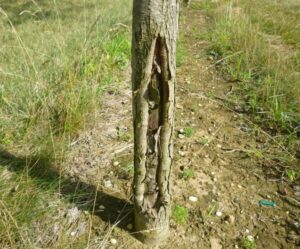
Sunscald wounds often never seal over & may increase in size as the tree grows. (Photo Credit: Steven K. Rettke, Rutgers Coop. Ext.)
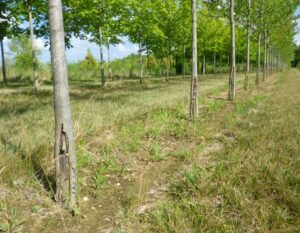
All nursery trees in photo show sunscald wounds on the southwest sides of trees. (Phot Credit: Steven K. Rettke, Rutgers Coop. Ext.)
Tree Wrapping:
Tree wrapping, or wrapping the trunk of young trees after transplanting, is generally not recommended. In the past, wrapping was done on fall transplants to reduce sunscald and frost cracks. However, replicated studies have shown that wraps are not a deterrent to these problems. Wrapping can create problems, by reducing photosynthesis (because young stems contain chlorophyll) and increasing potential pest attack from borers and certain diseases. The best benefit from wrapping is protection from chewing rodents. For this purpose, it should be in place only during the dormant season. In tree nurseries, wrappings can also help protect against deer rubbings.
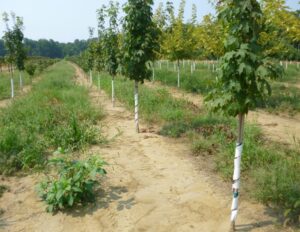
Trees in this nursery used tree wrappings to help protect against deer buck rubbings. (Photo Credit: Steven K. Rettke, Rutgers Coop. Ext.)

Deer buck rubbings on tree stems can cause significant injuries (Photo Credit: Steven K. Rettke, Rutgers Coop. Ext.)
Tree Staking:
With commercial nurseries, growers want rapid growth of trees and generally fertilize them heavily. Although this helps increase revenue from sales, it does cause potentially undesirable effects. The nursery grown trees usually need staking support because the fast growth causes the development of a large leafy upper canopy, but a tall thin, relatively weak trunk stem and a limited root system. However, in the home landscape, no staking is necessary for newly transplanted trees that are more moderately fertilized and can stand by themselves or have branches to the ground. Compared to rigidly staked trees, non-staked trees will develop a 33% greater basal trunk area, grow 19% less in height, develop a 30% greater trunk taper, develop a larger root system, develop more uniform xylem to support itself upright, and have few or no rubbing or girdling injuries. (Source: Harris, Arbor Age)
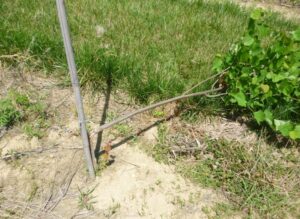
Despite tree staking in this nursery, it could not prevent breakage & loss of tree. (Photo Credit: Steven K. Rettke, Rutgers Coop. Ext.)
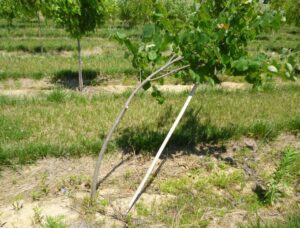
Although not needed in the landscape, tree staking of young trees growing in nurseries is often required. (Photo Credit: Steven K. Rettke, Rutgers Coop. Ext.)

